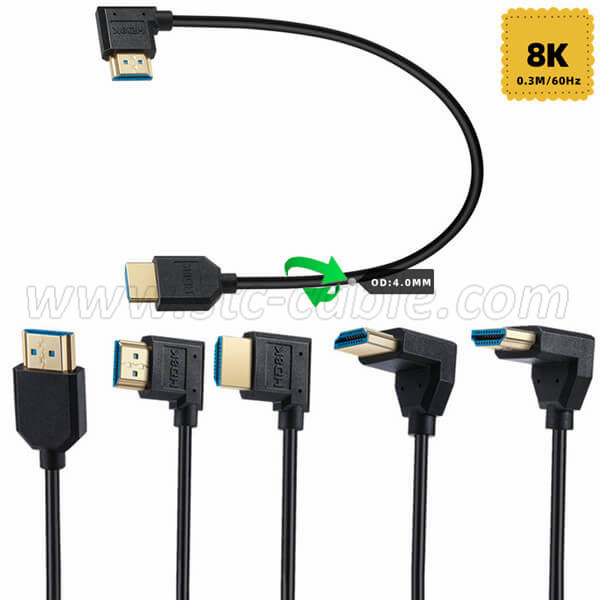What are the differences between using an HDMI cable for connecting a PC to a monitor and using it to connect a PC to a TV?
When connecting a PC to a monitor versus a TV using an HDMI cable, several key differences can impact your experience. Here’s a detailed comparison of what to consider for each setup:
1. Resolution and Refresh Rate:
1>Monitors:
Resolution: Monitors often support higher resolutions like 1440p, 4K, or even 5K, especially high-end models.
Refresh Rate: Monitors may offer high refresh rates such as 120Hz, 144Hz, or 240Hz, which is beneficial for gaming and tasks requiring smooth motion.
2> TVs:
Resolution: Most modern TVs support at least 1080p, with many now supporting 4K. Some high-end models may support 8K.
Refresh Rate: TVs typically have refresh rates of 60Hz or 120Hz, with higher refresh rates available in newer or premium models. However, TVs generally don’t reach the refresh rates found in gaming monitors.
2. Input Lag:
1> Monitors:
Input Lag: Monitors are generally designed with low input lag, which is crucial for gaming and applications where real-time responsiveness is important.
2> TVs:
Input Lag: TVs may have higher input lag, which can be more noticeable in gaming or interactive applications. Some TVs have a "Game Mode" that reduces input lag.
3. Color Accuracy and Calibration:
1> Monitors:
Color Accuracy: Monitors often have better color accuracy and calibration options, which is important for tasks like graphic design and video editing.
2> TVs:
Color Accuracy: TVs are designed to enhance video content with vibrant colors and contrast, but they may not offer the same level of precise color accuracy as professional monitors.
4. Screen Size and Viewing Distance:
1> Monitors:
Size: Monitors are typically smaller, ranging from 21 to 32 inches, although ultra-wide models are larger.
Viewing Distance: Monitors are meant to be viewed from a closer distance, providing higher pixel density and sharpness.
2> TVs:
Size: TVs are generally larger, often 40 inches or more, designed for viewing from a greater distance.
Viewing Distance: TVs are optimized for viewing from across a room, affecting pixel density and image sharpness.
5. Audio Features:
1> Monitors:
Audio: Many monitors have built-in speakers, but these are often basic. Users may prefer external speakers or headphones for better audio quality.
2> TVs:
Audio: TVs generally have better built-in speakers compared to monitors and may support advanced audio features such as Dolby Atmos.
6. Connectivity and Ports:
1> Monitors:
Ports: Monitors might offer a variety of ports including HDMI, DisplayPort, and USB-C. The availability and type of ports can vary based on the monitor’s design.
2> TVs:
Ports: TVs typically feature multiple HDMI ports, and may also include USB, component, and optical audio ports. They often have more HDMI ports compared to monitors.
7. Smart Features and Integration:
1> Monitors:
Smart Features: Monitors usually do not have smart features or built-in apps. They are straightforward devices designed primarily for display purposes.
2> TVs:
Smart Features: Many modern TVs come with built-in smart features, including streaming apps, voice assistants, and internet connectivity for accessing online content.
8. Aspect Ratio and Scaling:
1> Monitors:
Aspect Ratio: Monitors come in various aspect ratios such as 16:9, 16:10, or ultra-wide (21:9), catering to different use cases.
2> TVs:
Aspect Ratio: TVs predominantly use a 16:9 aspect ratio, which is standard for most video content.
9. Image Processing and Scaling:
1> Monitors:
Processing: Monitors typically have less aggressive image processing and scaling, focusing on delivering a clear image based on the input signal.
2> TVs:
Processing: TVs often include advanced image processing features to enhance video quality, such as upscaling lower resolution content to fit the screen and motion smoothing.
10. Usage Scenarios:
1> Monitors:
Usage: Best suited for tasks that require high resolution and low latency, such as productivity, gaming, and professional work.
2> TVs:
Usage: More suited for media consumption, such as watching movies and TV shows, with features optimized for entertainment and smart applications.
Summary:
While HDMI cables provide a standardized method for transmitting audio and video, the performance and experience can vary depending on whether you are connecting to a monitor or a TV. Monitors are generally better suited for high-performance tasks with higher resolution and refresh rates, while TVs are designed for larger-scale viewing and integrated media features.
Send your message to us:
Post time: Jul-18-2024
